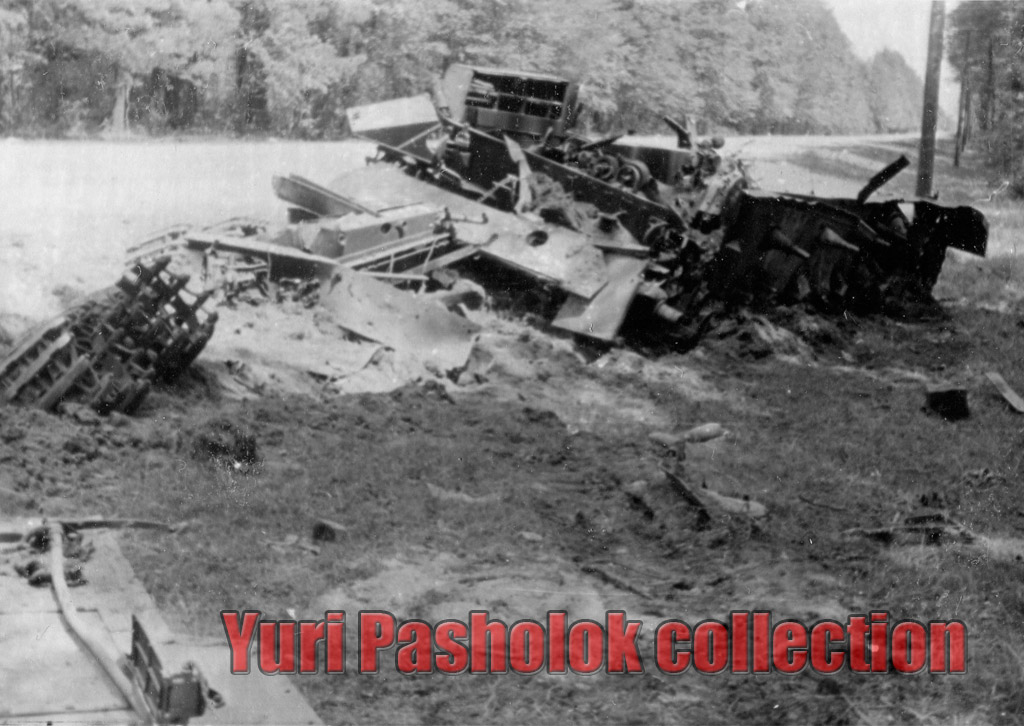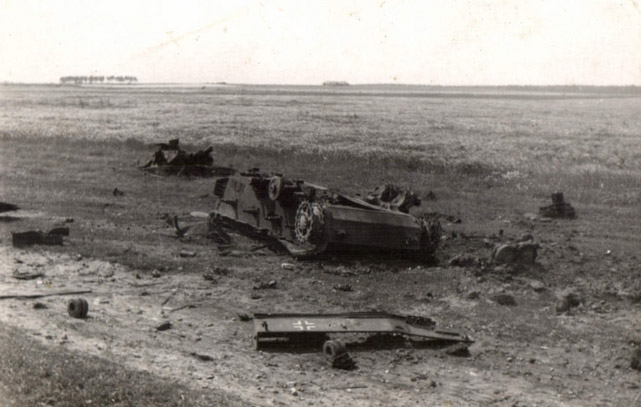Previous Q&A here.
Q: How effective was 152 mm HE against armoured targets? I’m interested in the KV-2 and SU/ISU-152. I’ve heard myths of turrets being blown off Tigers.
A: By the summer of 1941, the Red Army no longer needed the KV-2, so not a lot of them have been built. As a result (and due to the sparse photographic documentation from the Soviet side), not a lot has been written on the performance of its HE shells against enemy armour. However, there are some photos from the Germans.
The thin armour resulted in a nearly guaranteed penetration of the massive 152 mm shell into the tank, and then the explosion took out the ammunition rack, with predictable results. There was another article I read about pre-revolutonary 6-inch HE grenades flipping over tanks on impact, but it was likely a similar scenario to the one in the photographs.
This article contains some tests with 152 mm HE from the SU-152. However, the effect is similar: penetration of the HE shell, massive detonation inside. The integrity of the Panther tank struck by the shell was saved by a lack of ammunition inside it. As for knocking turrets off Tigers, Nikolai Konstantinovich Shishkin claims his shot knocked the turret off a Tiger tank, so that’s one instance, I guess. Direct hits from 122 mm guns could shift the turret off its turret ring and nearly shove it off the hull, so it’s not impossible that a little extra boost from the explosive filler in the 152 mm shell could push it off completely.
Q: I read that the USSR requested Matilda CS tanks with 76 mm howitzers as soon as they were available. In British service, this gun was only used to fire smoke. Was this the case for Soviet Matildas?
A: Seeing as how nearly every mention of the Matilda comes with complaints about lacking an HE shell, I doubt it. Sadly, the type of Matilda is never stated (if I’m lucky, whoever is writing the memoir will write “Matilda” or “Mk-II” instead of just “English tank”), so it’s hard to judge what kind of vehicle was used and when. I have read one instance of a Matilda commander correcting his tank’s indirect fire, so that was likely a CS version. Sadly, no mention of its performance was included in that memoir. I have only seen one Matilda CS in Soviet service on a photograph, so maybe they did not even order that many.
As for smoke, I have not seen any emphasis put on tanks firing smoke rounds in Soviet documentation, so it is very possible that these Matildas went into battle with HE alone.
Q: Was there a means for a Soviet tank commander to pass the target to his gunner?
A: Yes. As Soviet commander’s cupolas improved, they received means to turn the turret to where the commander’s periscope was pointing to speed up target acquisition, as well as markings for fire correction.
Q: Can you tell me more about a rangefinder that was installed on the T-35?
A: The T-35, with its 5 turrets, was very difficult for one tank commander to manage, leading to individual turret commanders seeking and destroying their own targets. Since ships also have the same problem, in 1935, the T-35 was equipped with a fire control system using a 9-foot Barr and Stroud rangefinder. However, since the system used an imported (and expensive) rangefinder, and its ugly armoured casing decreased the value of one of the T-35′s most important functions (serving in parades), the system was not mass produced.
That’s it for this time, email me more questions at tankarchives@gmail.com



Tried it in WT, you can flip SUs just shooting at his side
The Bullshit is strong in this one…
You Can Flipped a tank by ramming it from the side… Trust me i’m one of the Victim
And u can Front Flipped Ferdinand as well, i uploaded 1 Video On Youtube
https://www.youtube.com/watch?v=v92hG-MLMpo
LOL. Fall from around 15 feet.
“Track damaged”
- Don’t worry guys, I’m alright.
Ferdi tonk… stronk tonk.
So much bait in one section, not this time :3
As far as I remember, the Tiger of Michael Wittmann was once hit by an Su-152. The half of the turret was simply tired away … At least I’ve read it, but looking at the massive muzzle of the 152mm howitzer it could happens.
They survived ? I’d thought they got killed by spalling from such massive explosion…
SU-152 at the west front?
Remembering? Not good enough, documentation please, few tanks where lucky enough to survive the massive 152mm howitzer shell I highly doubt Wittmann and his crew would survive a direct hit by the 152mm in a Tiger when even the Tiger II cracked open like a sardine can.
Forget about moving the turret, the spalling was so bad it would instantly kill the crew not to mention to massive shockwave that would break every bones in their body and then we have the garbage German armour quality which just made spalling and cracking armour worse, all in all the Tiger would have ended up with a big hole in its side with crumbled and burnt steel graveyard inside of it.
The Germans feared the SU-152 and the IS-2 so much they ordered their tanks to avoid combat with them as much as possible and only flank or surprise attack them. Considering Wittmann had a braincell or two he probably would not like to face one of those big nasty monsters specially considering the Tiger had to close up closer than 600 meters in order to penetrate the IS-2 frontally.
John stfu about your uber sovjet supremacy propaganda and go kill yourself. Retarded piece of shit.
So butthurt. Much loser. What a mejved.
Good story. Needs more Soviet stronk, but good story.
So were Soviets to run and hide when the saw the Brummbar with it’s 150mm howitzer?
By that point they’d been dealing with Tigers for some time already; plus as the thing made its combat debut in Operation Citadel (ie. Kursk) with the Ferdinand the Soviets probably weren’t particularly fazed.
Pretty sure this was Carius, and in his case, an AP shell sheared away the commander’s cupola while he was bending down for a cigarette.
Yes EE, You are completely right. Sorry I’ve mixed up those Tiger-Aces (Wittmann and Carius) so SerB has also a point. Which I rod about it in a nutshell as follows.
The Tiger of Carius was attacked by two ISU-152. The first one shoot took indeed the right half of the commander’s cupola. But the second ISU-152 shoot the turret … Carius did not knew how hi escaped from the Tiger, but the only remnants of his tank was the headphone which hi wore.
Surely the fact that almost EVERY KV-2 that was produced in the 1 year they were made had NOTHING to do with the fact they were a HUGE poorly armored target and everything to do with they were so good at destroying their targets and widely successful at engaging the enemy and wiping them all out. I’m sure according to all the results they single handedly won the war, eh?
What are you on about?
Sounds drunk if you ask me. Certainly incoherent.
http://www.photo-war.com//lj/kvw/KV-DO_01.jpg
Wow
so poorly armoured
much penetration
such knocked out from AT guns (and not stuck in mud)
Ships only suffer when it comes to range-finding when they have guns on similar power, with the last pre-Dreadnoughts (including Semi-Dreadnoughts) being a prime example of this.
Such as 12 inch main guns being paired with 8 inch secondary guns.
Sounds like if one was unlucky enough to find themselves in front of these large caliber HE shells then yes they are effective. Though how likely would they be able to outmaneuver and spot to be able to employ them? Can someone point to memoirs telling how a soviet SU152 maneuvered/positioned to do this. I’d guess the enemy would probably be out numbered and/or encircled.
I understand SOP against enemy tanks was to take up ambush positions and attack with several vehicles at once, as the lenghty reload time was problematic if the first shot missed.
SU-152s operated in batteries. You are correct to assume that real life isn’t WoT, and nobody was going to sit there and DPM race against an enemy tank.
Seen plenty of pics of KV-2′s with neat holes punched through them where the tank crews sat , German gunnery was awesome.
But the modern historian is killing the Germans fighting qualities one article at a time.
Well the 88 FlaK *was* a pretty accurate gun.
Is that why AT instructions tell you to aim for the tank’s center of mass at over 400 meters? The accuracy of the FlaK 36 is not exceptional in any way.